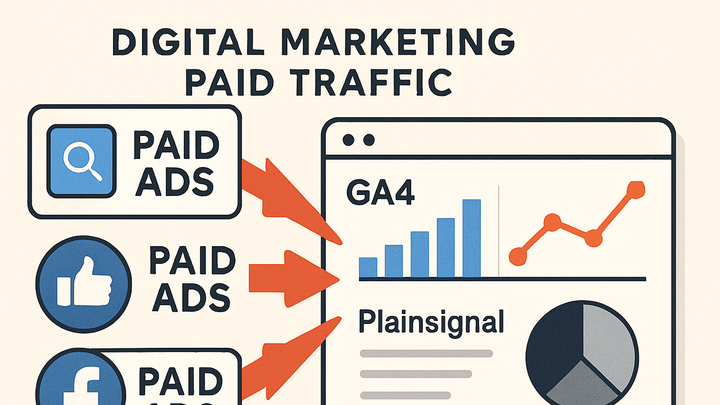Published on 2025-06-28T07:54:01Z
What is Paid Traffic? Examples of Paid Traffic Sources
Paid Traffic refers to website visitors acquired through paid advertising channels. This includes ads on search engines, social media platforms, display networks, and other digital channels where advertisers pay for placement. Unlike organic traffic, which is earned through SEO and content marketing, paid traffic is driven by investments in campaigns such as search ads, social media ads, and display banners. Marketers use paid traffic to quickly reach target audiences, control message timing, and optimize budgets based on performance. Analytics platforms like GA4 and PlainSignal allow you to track and measure the effectiveness of paid campaigns, analyze cost metrics, and attribute conversions accurately. By understanding paid traffic metrics, businesses can refine ad spend, improve return on ad spend (ROAS), and drive higher-quality leads.
Paid traffic
Website visits generated through paid advertising channels, tracked and measured via analytics platforms.
Why Paid Traffic Matters
Paid traffic plays a critical role in modern marketing strategies by delivering immediate visibility, precise targeting, and measurable outcomes. It allows advertisers to scale campaigns quickly, test messaging, and allocate budgets based on real-time performance data.
-
Immediate visibility
Paid campaigns offer quick exposure in search results and social feeds, ensuring your message reaches the audience promptly.
-
Precise targeting
Advertisers can target users by demographics, interests, location, and behavior, maximizing relevance and ROI.
-
Scalable budgets
Campaign budgets can be adjusted in real time based on performance data, allowing for flexible spending and rapid scaling.
-
Measurable results
Metrics like clicks, impressions, and conversions are trackable, enabling data-driven optimizations.
Common Paid Traffic Channels
Major channels advertisers use for paid traffic; each has unique strengths, ad formats, and targeting options.
-
Search engine ads (sea)
Text ads displayed in search engine results such as Google Ads and Microsoft Advertising that target keywords advertisers bid on.
-
Google ads
The leading search advertising platform with broad reach, keyword bidding, and advanced targeting features.
-
Microsoft advertising
Search ads on Bing and partner networks, often with lower CPCs and a different audience demographic.
-
-
Social media ads
Paid placements on social platforms to engage users based on interests, behaviors, and social connections.
-
Facebook & instagram ads
Offers detailed demographic and interest targeting across two major social networks.
-
Linkedin ads
Professional targeting ideal for B2B campaigns and lead generation.
-
Twitter & tiktok ads
Dynamic formats focused on engagement, brand awareness, and viral content potential.
-
-
Display & programmatic ads
Visual banner and video ads delivered across websites and apps via real-time bidding or managed channels.
-
Google display network
Serves image and video ads across millions of sites, reaching users as they browse the web.
-
Programmatic platforms
Automated buying using Demand-Side Platforms (DSPs) for optimized, data-driven ad placements.
-
Measuring Paid Traffic with Analytics Platforms
Analytics tools like GA4 and PlainSignal enable you to configure campaign tracking, attribute conversions, and analyze cost and performance metrics for paid traffic.
-
Google analytics 4 (GA4)
GA4 offers advanced event-based tracking, cross-device attribution, and seamless integration with Google Ads. Use UTM parameters on ad URLs to capture campaign source, medium, and name automatically.
-
PlainSignal
A cookie-free, GDPR-compliant analytics tool that focuses on privacy while providing essential traffic insights. PlainSignal uses privacy-preserving techniques to track paid referrals without relying on third-party cookies.
Example Tracking Implementations
Sample code snippets to integrate analytics for paid traffic tracking on your website.
-
PlainSignal tracking code
Include the PlainSignal script in your site header to start capturing paid traffic data:
<link rel="preconnect" href="//eu.plainsignal.com/" crossorigin /> <script defer data-do="yourwebsitedomain.com" data-id="0GQV1xmtzQQ" data-api="//eu.plainsignal.com" src="//cdn.plainsignal.com/plainsignal-min.js"></script> -
GA4 utm parameter examples
Add UTM parameters to ad destination URLs to attribute traffic in GA4:
https://www.example.com/?utm_source=google&utm_medium=cpc&utm_campaign=spring_sale
